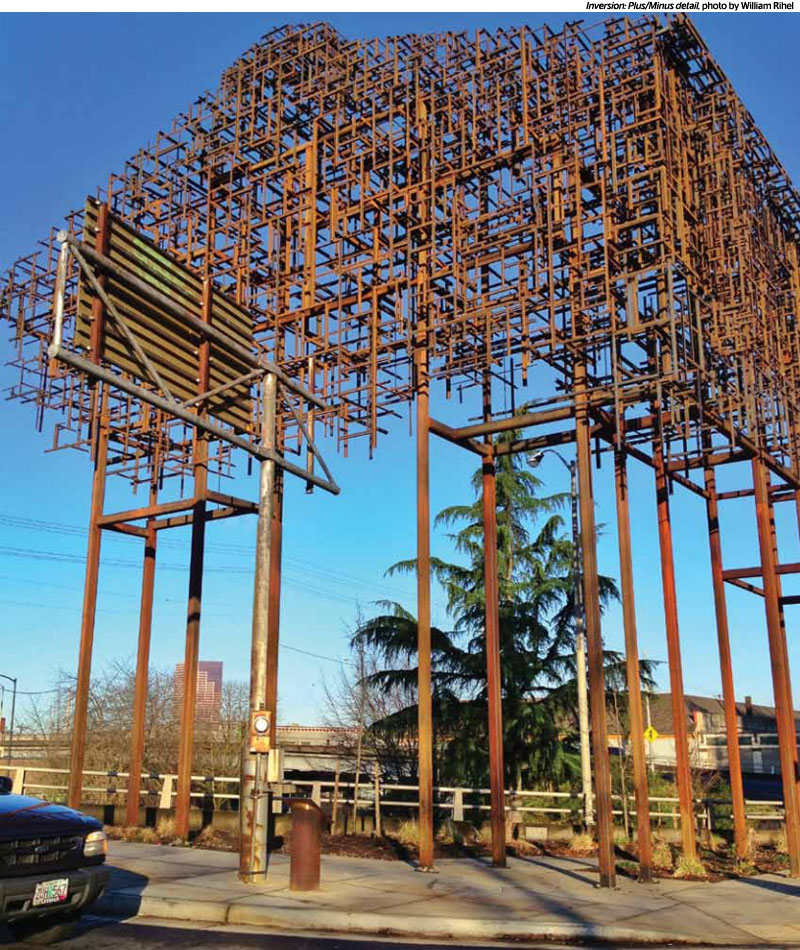PUBLIC ART
Monumental works take place along new streetcar line
AS EAST-SIDE commuters get used to the mammoth metal sculpture by the Hawthorne Bridge, the conversation it inspires is shifting from “What in the world is that?” to “Ah, it’s art, and it’s pretty cool.” When its fraternal twin goes up this year a few blocks north, by the Morrison Bridge, the two structures will be in conversation with each other, a call-and-response pairing of a positive and negative rendering of space.
The pieces line the Portland Streetcar’s east-side extension and were funded through the streetcar’s contribution to the Percent for Art program. The size of the streetcar project gave RACC, which oversees the city’s public art collection, the chance to do something big, with a $700,000 budget.
“I don’t think we’ll see another project on this scale for a while,” says public art manager Kristin Calhoun. “We could have taken these funds and divided them into ten smaller projects, but made the choice to do something bold and monumental.” She adds that RACC was excited about the chance to commission large-scale, highly visible works on the east side.
Working with a local selection panel that included artists, neighborhood business owners and employees, RACC used an invitational process to attract artists who demonstrated an ability to accomplish these kinds of projects.
The pieces by the Hawthorne and Morrison Bridges, collectively called Inversion: Plus/Minus, are the work of Lead Pencil Studio, founded by David Douglas grad Annie Han and Daniel Mihalyo, who are also responsible for the recently installed Non-Sign II at the US-Canada border in Blaine, Washington. The skeletal, seemingly floating buildings of Inversion: Plus/Minus are “ghosts” of the Phoenix Iron Foundry that used to be on the site, a marker of the area’s past. “We really wanted work that spoke to that neighborhood and its industrial sanctuary,” Calhoun says.
Han and Mihalyo are based in Seattle, but their work here certainly has “economic tentacles,” says Calhoun. “They moved to Portland temporarily, rented studio space, and hired local welders.” Those choices keep much of the investment in the community.
The other major artwork on the new line, a shelter to be built later this year at the streetcar stop where Broadway and Weidler converge, is the first municipal project in the US by Los Angeles–based Cuban-American artist Jorge Pardo, a recipient of a MacArthur Foundation “genius” grant. Given the long gray rainy season, the selection panel hoped Portlanders will appreciate the “boost of color” in Pardo’s work.
Portland and Multnomah County have Percent for Art ordinances, which call for two percent of most publicly funded capital construction budgets to be set aside for public art. RACC manages the funds and the artist selection process for the city and county.
Calhoun says “we are fortunate to live in a city where we prioritize creativity and the uniqueness of what artists contribute to the community.” RACC continues to look for ways to make sure that Portland’s public artworks reflect the whole city. “We take seriously that this is a collection for and of the community and needs to represent a diversity of styles, artists, and reflect the growing diversity of our city and region.”
“Everyone has their favorite pieces of public art, and we believe that the collection as a whole continues to give Portlanders something to be proud of,” says Calhoun. “Some works draw more attention than others—for better or for worse.”
With the size of these new works and their location on a major transit corridor, these latest pieces of public art are sure to be among the most noticed.

![]()
